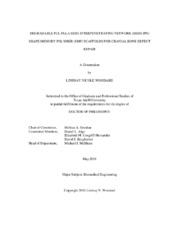| dc.description.abstract | Autografting remains the current gold standard in cranial bone defect treatment, yet procedures become difficult when trying to shape and fit rigid grafts tightly within irregular-shaped defects. A poor interface between the graft and surrounding bone tissue can result, leading to graft resorption and failure. Tissue engineering provides a promising strategy to overcome grafting shortcomings. To be effective for defect healing, a scaffold for tissue regeneration must (1) have interconnected macropores, (2) be mechanically robust, (3) biodegrade with neotissue formation, (4) be bioactive and (5) be able to achieve defect-specific geometries, permitting osseointegration. A scaffold uniquely able to conformally fit within a defect via shape memory polymer (SMP) properties is particularly interesting. In this work, macroporous SMP scaffolds were developed based on semi-interpenetrating networks (semi-IPNs) of thermoplastic poly(L-lactic acid) within cross-linked poly(ε-caprolactone) diacrylate (PCL-DA). Towards modulating and optimizing mechanical and degradation properties, PCL-PLLA semi-IPN parameters including PCL:PLLA weight % ratios (100:0 [PCL-DA control], 90:10, 75:25, 60:40) and PCL-DA degree of polymerization (n; n = 25, 45) were varied.
PCL-PLLA semi-IPNs were initially evaluated in terms of bulk material properties. The semi-IPNs were found to possess PCL crystalline domains needed for shape memory capability. Additionally, an enhancement in mechanical properties was observed for PLLA-containing semi-IPNs over PCL-DA controls. Degradation was also found to be highly-accelerated with the addition of PLLA. Upon extensive evaluation of PCL-PLLA semi-IPN degradation, it was concluded that reduced PCL crystallinity upon cross-linking (i.e. PCL-DA) and PCL-PLLA phase separation contributed most significantly to rapid degradation rates, notably over PCL-PLLA thermoplastic blend controls. While surface erosion was observed, it remains to be determined if the results were a by-product of alkaline testing conditions. The PCL-PLLA semi-IPNs may overcome the limitations of common, slow-degrading biomaterials. Further, porous PCL-PLLA semi-IPN scaffolds were fabricated via a solvent-casting particulate-leaching (SCPL) technique that resulted in macroporous interconnectivity. Via heat treatment, a range of pore sizes and porosities was realized. The semi-IPN scaffolds displayed shape memory ability, enhanced mechanical properties and tunable, accelerated degradation rates. Overall, such scaffolds possess great potential for bone defect healing, which will be assessed in the future. | en |


